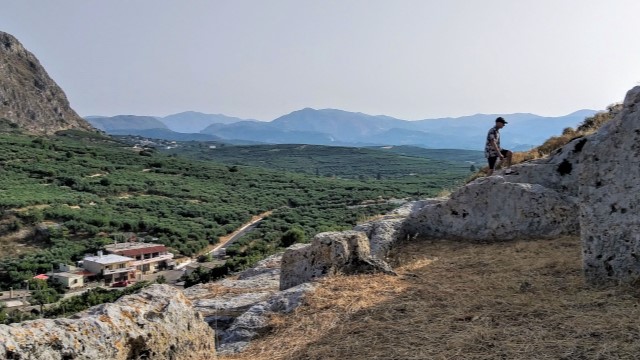By Lisa Radinovsky from Greek Liquid Gold.
My first encounter with the archaeological site of Ancient Rokka took place at night, accompanied by my two small children, a crowd, and an orchestra. It was the night of the August full moon, when Greece celebrates the summer with special events, including a live outdoor musical performance on a steep, rocky hillside above a village in northwestern Crete.
My children, my husband, and I struggled to find our way on the rough ground as night fell, but once the orchestral music engulfed me and I considered our unique position below the remnants of an ancient town and across the gorge from dramatic cliffs, I realised I needed to return by day. (This time lapse photography gives you some idea of the 2021 version of a similar event, but I remember more darkness and mystery at an earlier edition of it.)
Years later, I was visiting a beloved olive mill destination, Biolea, with my brother Dean in the same part of Crete. We had toured the updated version of an old-fashioned stone mill and hydraulic press on another visit; that day, we sampled Biolea’s organic extra virgin and flavored olive oils and drank coffee at their café. (On a different occasion, I enjoyed a fresh lunch there with Canadian friends who deemed the salad the best they’d had on their entire visit to Greece).

Looking beyond Biolea’s olive groves, which extend toward two rocky hills and seem to disappear into the deep gorge between the hills, Dean and I were struck by a particularly intriguing hill on the far side of the gorge, with a wide open slanted space cut off by descending cliffs on the long side facing us and a vertically ascending rocky ridge at the other end. This is the hill called Trouli, home of the archaeological site of Rokka.
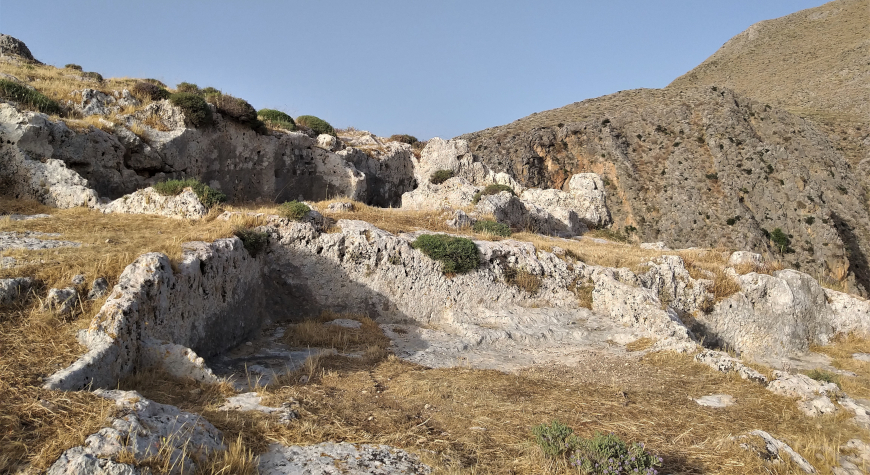
We debated whether to visit the sculpturesque ancient olive tree of Ano Vouves on our way back to Chania, because the intricate design and rough texture of its 3,000 to 5,000 year old massive hollow trunk has fascinated us since we first saw it. This time, we decided to head the other way, to Ancient Rokka. Dean’s GPS surprised me by accurately directing us along tiny village lanes, past a church with remnants of very old frescoes, up and down scenic olive-covered hillsides, and over narrow dirt roads through olive groves to the little village of Rokka. Once there, we asked friendly villagers how to find the archaeological site.
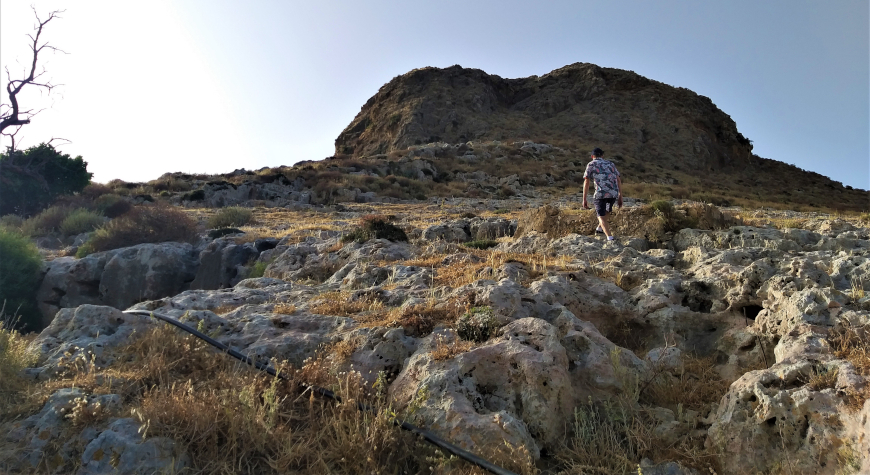
Αs we climbed the steep, rocky hill that June evening, we were glad to be wearing good walking shoes and relieved that we had avoided the midday sun. We wondered if we should venture all the way to the top, beyond the ruins we could see initially. There is even more to explore, including the remains of the acropolis and Byzantine fortress, as well as a stunning view of the surrounding landscape and the sea, as I learned from this drone video. However, at about 265 meters above sea level, the fortress appears very difficult to access, and we were adequately fascinated by what we found below it.
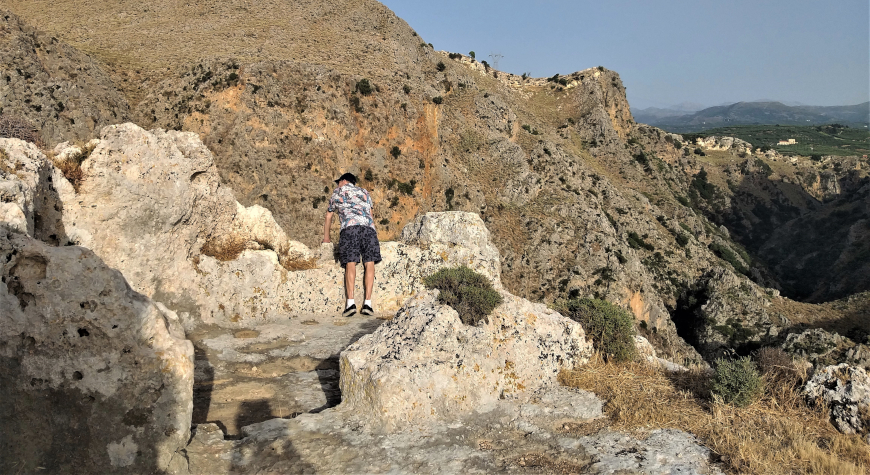
Remnants of walls carved into the rock of the hillside mark the boundaries of age-old rooms, some with doorsteps very close to the edge of the gorge. Their residents do not appear to have suffered from a fear of heights; a misstep could lead to a precipitous drop off nearly vertical cliffs.
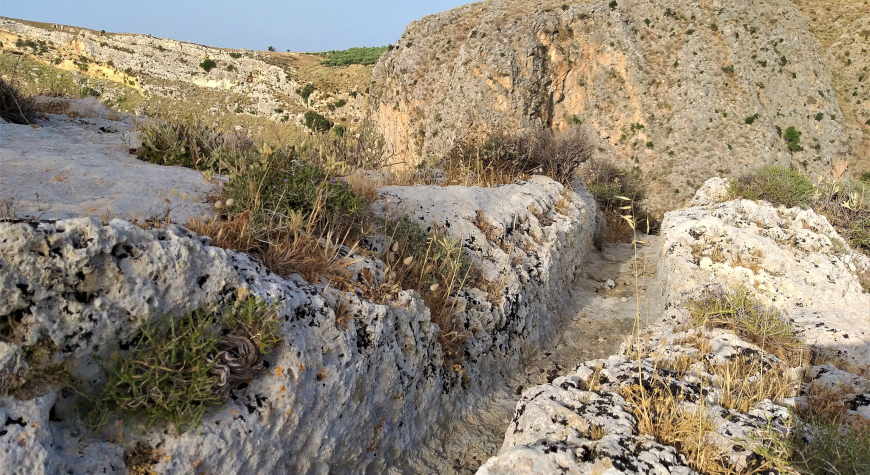
Grooves cut into the stone must have channeled water toward the gorge that runs between cliffs, heading back toward Biolea. A stone step or two remain here and there. According to Angelfire, “objects have been unearthed here that date from the 5th to the 2nd century BC.”
Higher up, we find small rectangular indentations and caves—very low-ceilinged little rooms, or animal shelters?–carved into the hillside. A curiously low doorway and wide rectangular opening are cut into the rock below dry grasses and wild shrubs that grow up to the edge of the stony ridge.
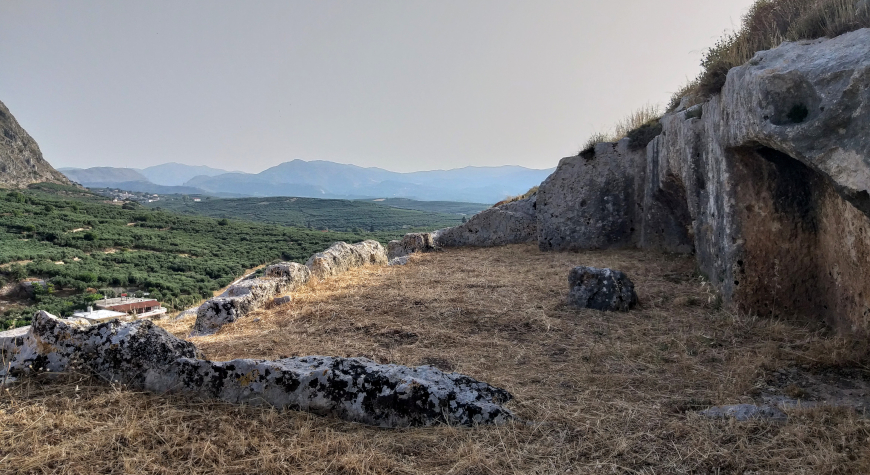
However it was used millennia ago, the flat area in front of the cave room and indentations now forms a wonderful observation deck. It offers a panoramic view of the steep, dry rocky hills across the deep gorge from us (to our left and in front of us), and below us to the right, plains covered with olive groves stretching beyond the handful of village houses toward the foothills of the White Mountains that fade into the distant south.
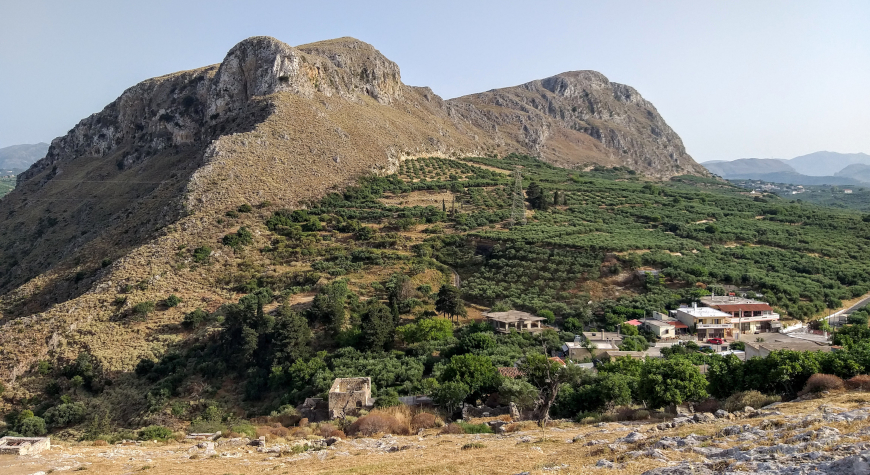
Earth tones predominated on that June evening: shades of brown, green, off-white, gray, black, and rusty orange beneath the pale blue sky of early evening, with a few delicate wildflowers adding tints of pink and purple and the slanting sun diffusing a warm glow. Consider visiting Ancient Rokka in the early evening on a clear, calm day if you appreciate the way the sinking sunbathes vistas of hills, cliffs, and olive groves in its gentle light.
*Originally published on Greek Liquid Gold: Authentic Extra Virgin Olive Oil (greekliquidgold.com). See that site for recipes with olive oil, photos from Greece, agrotourism and food tourism suggestions, and olive oil news and information.

